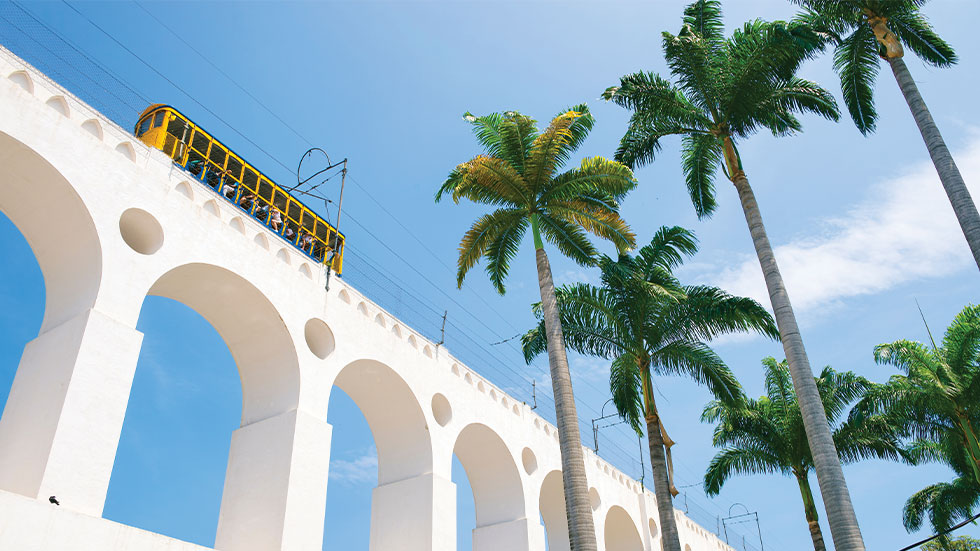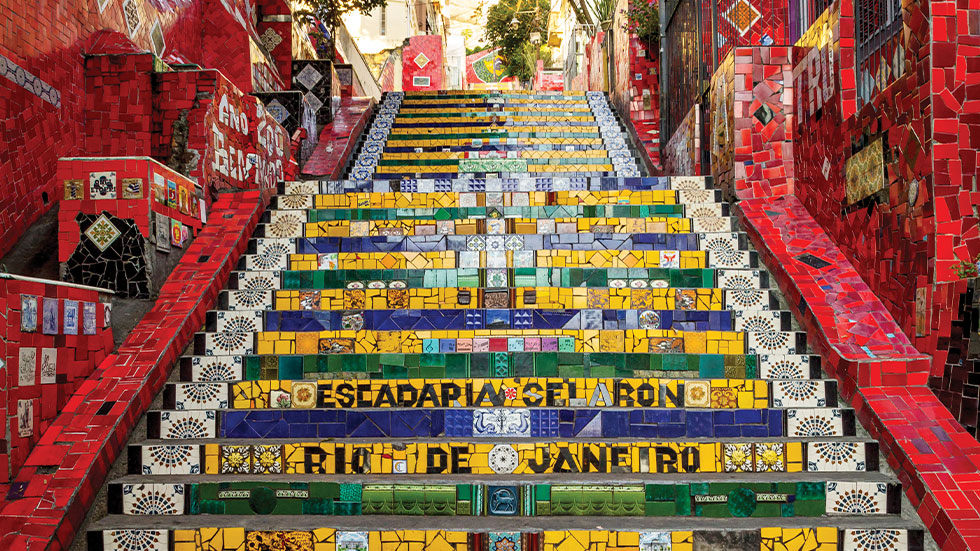Three Great Neighborhoods to Check Out in Rio de Janerio
With sand, sun, and standout attractions, Rio delivers the perfect escape

My husband Scott’s birthday arrived deep in a Mid-Atlantic winter of lead-gray skies and freezing temperatures. So, I decided to book an escape to summer in the Southern Hemisphere as a gift to him. A 10-hour flight from New York’s JFK Airport would land us in Rio de Janeiro, Brazil, with its sunny 80-degree days and palms swaying on the beach. Even the sound of the city’s name—Rio—salsa’d off my tongue.
Rio is all the things you’ve heard: large (a population of 6.7 million), loud and fun. (Its famous Carnival, which draws travelers from around the world, had concluded the week before we arrived.) The pulse of the city is defined by the 56-mile stretch of sand that wends along the Atlantic Ocean. The beaches are all public, and on any given day, you can find them populated by schoolkids casting off their book bags for impromptu soccer matches alongside businessmen who have stripped down to their swim trunks for a game of volleyball and retirees who let the warm waves lap at their ankles. White high-rises rush toward the sea along streets shaded by almond and ficus trees and brightened by sprays of bougainvillea, all surrounded by lush mountains and majestic rocky peaks.
Over the course of a week, Scott and I based ourselves in three distinct neighborhoods—Ipanema, Copacabana and Santa Teresa—hoping to break this sprawling city into knowable parts.
 Rio de Janeiro with Sugarloaf Mountain in the distance; Photo by Nido Huebl/stock.adobe.com
Rio de Janeiro with Sugarloaf Mountain in the distance; Photo by Nido Huebl/stock.adobe.com
IPANEMA
We began our stay in Ipanema, an enclave favored by the trendy and well-heeled, made famous by Antonio Carlos Jobim’s “The Girl From Ipanema.” You can visit La Garota, a low-key steak joint where the song was written in 1962, and catch live music across the street at Vinicius, an atmospheric bossa nova club.
Galleries, boutiques and cafés are tucked among a warren of streets. It’s here that I discovered a two-story bookshop called Livraria da Travessa, kitted out with leather chairs, globes and a small but mighty English language section. Nearby, we popped into H. Stern Museum, run by South America’s largest gem dealer. Sure, you can buy gorgeous baubles such as Brazil’s national gemstone, the pink-hued imperial topaz, but we didn’t. Instead, we whiled away an hour learning some geology about how these magnificent gems were formed.
 The intricately tiled boardwalk of Ipanema Beach; Photo by marchello74/stock.adobe.com
The intricately tiled boardwalk of Ipanema Beach; Photo by marchello74/stock.adobe.com
But of all its treasures, Ipanema is most prized for its 1.5-mile stretch of beach, arguably the finest in Rio thanks to its crystal-clear water and impeccably clean sand. Pop-up entrepreneurs hire out their services as beach attendants, ferrying chairs, umbrellas and milho cozido (steamed ears of corn), a popular beach snack here, from nearby vendors. The boardwalk, like all of those in Rio, is better described as a walkway fashioned from black-and-white Portuguese tile. In Ipanema, the stones are set in a distinctive mod 1960s pattern.
We stayed at the Ipanema Inn, a boutique hotel a block from the beach. Downstairs, one of Ipanema’s hippest restaurants, Quitéria Café, serves coffee and rosé all day, and it’s here that we sampled tapioca rendada, a Brazilian pancake stuffed with mushrooms and cheese.
One evening, we sought out one of Ipanema’s buzzy tapas bars, Boteco Belmonte (boteca in Portuguese translates to tapas), where locals gather downstairs for shrimp empanadas and a chopp, or draft beer, and where couples head to the rooftop to capture the moon rise over the ocean.
 The wave-inspired walkway at Copacabana Beach; Photo by lazyllama/stock.adobe.com
The wave-inspired walkway at Copacabana Beach; Photo by lazyllama/stock.adobe.com
COPACABANA
Copacabana is Ipanema’s bolder, brasher sister. Throngs of joggers, hawkers, dog walkers and skateboarders make the boardwalk, this one patterned with the wiggle of sea waves, frenetic. The beach is noisier, with more people, more music and more vendors, and the streets are more urban—a combination of commuter bustle, panhandlers and residents hustling on errands.
 Copacabana Palace; Photo courtesy of Belmond
Copacabana Palace; Photo courtesy of Belmond
Scott and I sought refuge at the Copacabana Palace, A Belmond Hotel, an iconic white confection that defines the beachfront of Rio. Built in 1923 to resemble seaside hotels in the South of France, it has been welcoming presidents and pop stars for more than 100 years. On the terrace of its poolside restaurant, I tried my first caipirinha, the unofficial national drink of Brazil made from cachaça (fermented sugarcane juice), lime and sugar. I paired it with canastra cheese, a distinctive raw cow’s milk cheese with a spicy kick made only in Brazil.
The Olympic-size pool set in the courtyard a story above the fray of Copacabana feels more like a country club than a hotel thanks to a friendly staff and a cadre of guests who make the regular rotation to this beautiful spot under the sun. This is where Scott decamped for most of our stay, reading, dipping in the water and sipping on Guarana, a soda that taps a crisp fruit from the Brazilian rainforest for its flavor.
 Copacabana; Photo by ekaterina belova/stock.adobe.com
Copacabana; Photo by ekaterina belova/stock.adobe.com
Tempting as it was to spend all our time at the Belmond, we couldn’t skip the beach. The hotel has its own beach attendants waiting across the street on the sand, and we were grateful. They not only carved out a restful spot for us on the otherwise-boisterous beach, but they also brought us umbrellas, beach chairs and fat coconuts with drinking straws while we lounged seaside.
To fully capitalize on the luxe side of life in Copacabana, we booked dinner at the Michelin-starred Ristorante Hotel Cipriani, where a glamorous dining room sets the stage for Chef Nello Cassese’s sometimes-playful tasting menu. (How about a chocolate cigar perfumed with actual tobacco smoke?) At the end of the meal, the chef sent us off with a sphere of dense chocolate cake studded with soft almonds, made from his Italian grandmother’s recipe, that we devoured in our room the next morning as we watched the rising sun cast sherbet tones over the ocean.
 A historic tram line connects center city Rio with the Santa Teresa neighborhood; Photo by lazyllama/stock.adobe.com
A historic tram line connects center city Rio with the Santa Teresa neighborhood; Photo by lazyllama/stock.adobe.com
SANTA TERESA
We next headed to the hills via a 10-minute cab ride from the beachfront to Santa Teresa. Its steep and circuitous cobblestone streets require good walking shoes and a dose of determination, though you can hop on and off a canary-yellow tram that’s been lugging people around for more than 100 years. Santa Teresa is named for the convent that essentially established this neighborhood. The chapel, which dates to 1629, still holds Catholic Mass weekly. This section of Rio is known for its extraordinary array of architectural styles, from neo-classical to Gothic, Tudor to Byzantine. Carioca Montmartre, a fairy-tale castle built in the 1880s, all spires and turrets and towers, crowns the district.
 The mosaic staircase of Escadaria Selaron; Photo by Mikolaj Niemczewski/stock.adobe.com
The mosaic staircase of Escadaria Selaron; Photo by Mikolaj Niemczewski/stock.adobe.com
Today, Santa Teresa is an edgy artists’ enclave. Round a corner and find an abandoned home next door to an inviting restaurant, like Bar Do Mineiro, where locals linger over pasteis, savory deep-fried pastries, and tutu de feijao, a hearty bean and meat stew. Up the street? Perhaps an art gallery, a hip boutique or Escadaria Selaron, an artist’s vision for a staircase linking two neighborhoods that has been painstakingly adorned with a mosaic decorated by Chilean artist Jorge Selaron with 2,000 colorful tiles from around the world.
Scott and I stayed at the 44-room Santa Teresa Hotel RJ-MGallery, tucked into a lush corner of this bohemian district and featuring pocket gardens, a chic pool overlooking downtown Rio and an art-filled lobby. References to its former life as a coffee plantation include bedside coffee-infused crackle cookies and complimentary iced coffee served all day.
 Rio’s iconic Christ the Redeemer monument opened in 1931; Photo by Sonny/stock.adobe.com
Rio’s iconic Christ the Redeemer monument opened in 1931; Photo by Sonny/stock.adobe.com
THE ICONS
While in Rio, we saw representations of Christ the Redeemer almost everywhere—from plastic figurines sold at airport gift shops to tie-dyed T-shirts emblazoned with the image for sale at the beachfront market to the actual Christ the Redeemer statue, which soars 2,300 feet above the city and has a 92-foot span, thanks to those outstretched arms. The best view of this marvel made of reinforced concrete and soapstone is from the ground, but if you want to stand in its shadow, take the earliest cog train up the steep Corcovado Mountain, departing at 8:30 a.m., before the crowds overwhelm the site.
 A cable car brings visitors to the top of Sugarloaf Mountain; Photo by f11photo/stock.adobe.com
A cable car brings visitors to the top of Sugarloaf Mountain; Photo by f11photo/stock.adobe.com
Rio’s other famous feature is Sugarloaf Mountain, which rises about 1,300 feet above the harbor. The cable car system here tends to get jam-packed (2,500 people ride it each day), but if you go early in the morning, you can stake out a place against a gondola window for a 360-degree view of the entire city, including the favelas, the densely populated poor settlements that cling to the face of the mountains. Make time to pause after the first leg of the journey on the lower summit to watch the marmosets, friendly monkeys that scramble down the tamarind trees to greet visitors.
On our final day, Scott and I splurged on a helicopter ride above the city. We did a loop around Christ the Redeemer, getting close enough to see the cracks in the statue’s palms, caused by a lightning strike. We hovered above “our” neighborhoods—Ipanema, Copacabana and Santa Teresa. We soared above the stark beauty of the mid-century modern towers downtown and swept over the seemingly endless beach. And then, suddenly, I spotted a cove tucked beneath a craggy rock jutting toward the sky and lunging at the water, the froth of the ocean pounding the shore.
I tapped Scott and pointed below. He nodded vigorously. The pilot tried to tell us what it was, but her voice was faint, muffled by the sound of the helicopter. That was okay. We had discovered another facet of Rio to explore. It was certain: We would return.
